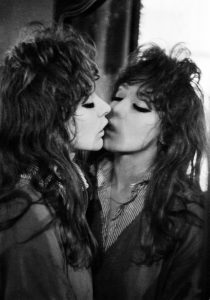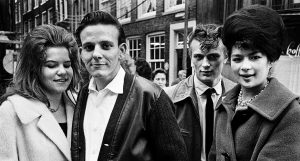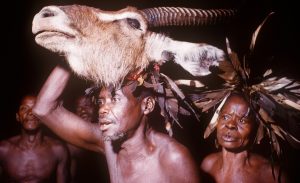If he could have, photographer Ed van der Elsken would have preferred to have a camera built into his head, to capture the world twenty-four hours a day. What he did manage to make are countless beautiful photographs, films and books. The Stedelijk Museum in Amsterdam shows his rich legacy at the major exhibition The camera in love.

He was quirky, committed, incredibly passionate and you would call him the first vlogger himself avant la lettre could call it. Ed van der Elsken (1925-1990) was one of the great Dutch photographers of the last century, and a versatile artist. That many of his images have iconic quality is apparent as soon as you enter the exhibition The camera in love at the Stedelijk Museum in Amsterdam. In each room, a blow-up covering the entire wall immediately attracts attention, such as the picture of his muse Vali Myers kissing herself in the mirror - an image that is still world-famous today. He made the portrait early in his career, when he followed a group of young bohemians (including Myers) in Paris who were killing their time on the streets and in bars.
Right from that early work, you can see his social engagement and idiosyncrasy: the realism Van der Elsken was at odds with the positive zeitgeist of the time, and his focus on youth culture and the fierceness and addiction that came with it was completely new. Edward Steichen, who in a photograph of Van der Elsken selected the exhibition The Family of Man at New York's Museum of Modern Art (the world-famous photographic exhibition is still on display in Luxembourg more than sixty years later!), encouraged the Dutchman to make a book of his Parisian work. And he did. A love story in Saint-German-des-Prés was his first picture book, and Van der Elsken immediately made his name with it in 1956.
Shocking
However, his raw images also provoked resistance, says curator Hripsimé Visser. She points to one of the display cases, in which lies an article from Vrij Nederland, announcing the work as: 'Shocking Paris photo book'. 'It was the 1950s, the period of reconstruction, young people were supposed to be fresh and fruity. Van der Elsken showed a very different picture. It is often thought that these young people were existentialists, but they were mostly anarchist young people who were very bitter and turned to dope and alcohol in disappointment.'

Ordinary people on the streets of Amsterdam, Paris or Japan, punks, Hell's Angels and prostitutes - Van der Elsken spoke and worked with people from all walks of life and all cultures. His love for the world and people translated into photographs and films in various ways. For example, an excerpt can be seen from the serious, moving documentary about demolition of the Jewish neighbourhood in Amsterdam after World War II - because the houses were no longer full, but moreover because there were not that many residents left.
Vlogger avant la lettre
In his documentaries, Van der Elsken was as unconventional as in his photography: the maker himself was often emphatically present (sometimes even the protagonist) in his films, which was very unusual at the time. You could even call him a vlogger avant la lettre, though of course the internet did not yet exist. When he needed money for the world trip that formed the basis of his picture book Sweet Life, in fact, he suggested to the Avro to travelogues make short films that were shown on television. Only the first film and a montage have survived, and excerpts of these can be seen at the exhibition. 'Ed once said that he would prefer to have a camera built into his head, to twenty-four seven being able to capture everything,' Visser laughs.

Although Van der Elsken became best known as a street photographer, he let The camera in love show that he did also stage photographs and placed great value on composition; he made sketches of his ideas, combined and edited images to create captivating diptychs or reflections. He also photographed a lot in colour, such as for the photo book Bagara about his trip to Africa, where, among other things, he shot a poignant photo of a baby elephant just removed from its dead mother's womb.
Japan was also a favourite destination. Travelling he did a lot. 'In the 1960s and 1970s, he worked for the glossy Avenue, for which he travelled with great authors such as Cees Nooteboom or Harry Mulisch. Ed was someone who occasionally worked on commission, but preferred not to. He was actually one of the first autonomous photographers. He initiated his own commissions, his own books, his own travels.'
Sculptural
Not only was Van der Elsken highly regarded in his own time, he also influenced later professionals. The famous American photographer Nan Goldin, for instance, admired Van der Elsken and considered him her forerunner. Even today, his work is much loved. 'He was very good at taking strong photographs, he made powerful compositions,' Visser said. 'He studied sculpture, and the way he put people, bodies and shapes in space often has something sculptural about it.'

She points to a photograph of women on a bench, with a standing man in front of it, like an aura of light around his head. 'Every photographer holds back or sometimes gives more light to give more expression. This here is a flaw that comes from not being too precise with that. But Ed plays with that and uses it to highlight a person, like a holy white man. He wasn't a photographer of the neat rules, he didn't work by the book.'
At the end of the exhibition, visitors literally say goodbye to him. Van der Elsken, once he knew he wasn't going to beat prostate cancer, said goodbye as befitted him: by capturing it on film. Bye is a moving self-portrait of a dying man, a worthy finale by an inspired artist.
Ed van der Elsken - The camera in love can be seen from 4 February to 21 May at the Stedelijk Museum in Amsterdam. The exhibition offers the largest survey worldwide of his photography and documentaries, and highlights the relationship between his life, books and films. There is also plenty to do around the exhibition. EYE offers a special film programme around different themes in Ed van der Elsken's work. The Stedelijk will also offer digital interactive stories about Ed van der Elsken, a lecture programme, a seminar on 12 February and three photography workshops, the final results of which will be shown on the final evening of the exhibition. Also, young people, known as Blikopeners, will give a guided tour every Friday evening that provides a particular Ed van der Elsken view of the exhibition - including coloured glasses. www.stedelijk.nl
